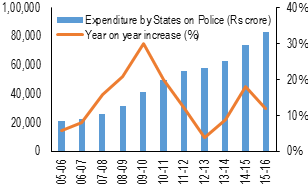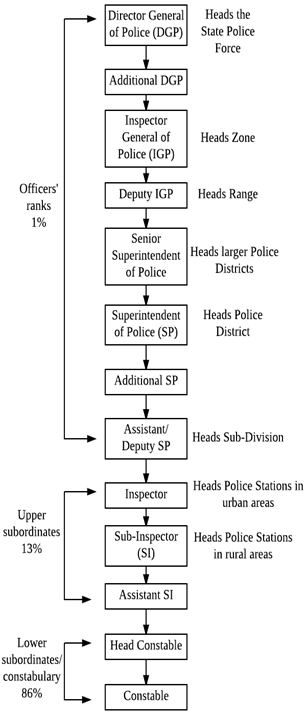
Police reforms
History of policing in india-
- Following the 1857 uprising, the British established a police force with the primary objective of defending their imperial interests.
- During the war for liberation, they mostly deployed the police to repress and imprison revolutionaries and freedom fighters.
- In the years that followed Independence, the police force lost its reputation as a people-friendly force and came to be perceived as elite and power-friendly.
- Misuse of Policing: Under the emergency, thousands of people, including all the political opponents of the ruling regime, were imprisoned and human rights were suppressed with impunity.
- National Police Commission:
- A National Police Commission was subsequently established in 1977, and its conclusions contained comprehensive, multifaceted proposals for police changes.
- Reforming police forces at the individual and institutional levels has not progressed very far.
|
Underreporting of crime in India
|
OVERVIEW OF POLICE ORGANISATION AND FUNCTIONING
- State Police Forces- State rules and regulations apply to the police forces of the various states. Some states have based their legislation on the Police Act of 1861, a federal statute. States also have their own police manuals that outline how the state's police are set up, their responsibilities, the records they must keep, etc.
- Hierarchy and organization- Civil and armed police make up the two main branches of state police services. The civil police are in charge of maintaining daily peace and order and reducing crime.
|
Hierarchy of state police |
Superintendence of the executive-
- The state police forces are governed and overseen by the state government. At the district level, the District Magistrate (DM) has the authority to direct the SP and oversee police operations. Since both the DM and SP have equal authority, this is known as the dual system of control at the district level.
- The Commissionerate system, however, has replaced the dual system in some large cities and urban regions to enable quicker decision-making in response to complex law-and-order crises. 53 cities, including Delhi, Ahmedabad, and Cochin, had this system as of January 2016.
|
Dual system |
Commissionerate system (53 cities) |
|
|
Recruitment and Training
- Constables, Sub-Inspectors, and Assistant or Deputy SPs are the three levels of direct recruiting within the state police forces. Direct recruitment of police officers into the ranks of Constables, Sub-Inspectors, and Deputy SPs is the responsibility of the state governments. For the position of Assistant SP, the central government hires members of the Indian Police Service (IPS). An All India Service called IPS was established under the Constitution. Promotions may be used to fill openings at other positions (as well as at the ranks of Sub-Inspector and Assistant/Deputy SPs).
Expenditure by states on police over the last decade
- States (apart from union territories) spent Rs 77,487 crore on state police forces in 2015–16, which included money for wages, equipment, housing, and transportation. Because the police are a personnel-intensive department, the majority of this expenditure was on revenue items like salaries. 3 percent of the entire budget for states was allocated to police expenses (i.e. Rs 27,20,716 crore). The cost of policing has grown by 15% a year on average over the past ten years, while there have been significant fluctuations (4% in 2012–2013, 30% in 2009–2010).
Issues /challenges
- Poor police-population ratio: As of January 2016, there were over 5.5 lakh vacancies in state police forces or 24% of the total. So, in 2016, the authorised police strength was 137 police, compared to the actual strength of 181 police per lakh people. Notably, the United Nations has recommended 222 police officers per lakh people.
- Understaffing causes police officers to be overworked, which not only affects their efficacy and efficiency (resulting in subpar investigations) but also causes psychological suffering and prolongs the pendency of cases.
- Political Superimposition:
-
-
- In accordance with police regulations, political executives have power over both the Central and State police forces. Political leaders frequently alter police objectives in accordance with the state's political climate.
- In 2007, the Second Administrative Reforms Commission made the observation that political figures improperly influenced police officers for partisan or personal ends.
-
- Colonial Legacy: The British people passed the Police Act of 1861 to modernise the nation's police system following the uprising of 1857. After 75 years of Republic India, this act does not reflect the democratic aspirations of the populace.
- Public Perception: According to the Second ARC, police-public relations in India are unsatisfactory because citizens regard the police as dishonest, ineffective, and unresponsive. As a result, they frequently hesitate to approach them.
- Infrastructural Deficit:
- Modern weapons, robust communication equipment, and high mobility are essential for today's police forces. State police units have reported having a lack of weaponry, according to CAG audits for 2015–16.
- The Bureau of Police Research and Development has also identified a 30.5% shortage in the state forces' inventory of necessary vehicles.
- Changing Technology, Challenging Policing:
- Digitalization, hyperconnectivity, and the exponential rise of data are all predicted to pick up speed in the coming ten years.
- The blending of many sectors, such as bioweapons and cyberattacks, poses a challenge to efficient enforcement.
Efforts taken by the government of india
- The Indian government has taken a variety of steps to improve policing, including
- a programme to decriminalize minor offences and violations
- The Identification of the Prisoners Act, 1920, a piece of legislation that was enacted more than a century ago, is being modified.
- The Prime Minister is advocating for a police force that is SMART, which is:
- Strict and Sensitive,
- Modern and Mobile,
- Alert and Accountable,
- Reliable and Responsive,
- Tech-savvy and Trained.
- One of the main goals of the administration is to further integrate technology into everyday police operations.
- The Indian Police Foundation is making efforts to bring internal reforms, technology adoption, digital transformation, and training to strengthen the professional and ethical standards of the police to realize the vision of a SMART Indian Police.
Directions of the Supreme Court in Prakash Singh vs. Union of India -
- Context-A petition that accused the police of abusing and misusing their authority was presented to the Supreme Court in 1996. It claimed that laws were not enforced and were applied in a biased manner in favour of powerful people. It also brought up incidents of unauthorized detentions, torture, harassment, etc. against regular people. In the petition, it was requested that the court issue directives for the application of expert panels' recommendations.
- Directions-
- Create a State Security Commission in each state that will establish guidelines for how the police should operate, assess the effectiveness of the police, and make sure that the state governments are not abusing their power to influence the police.
- Create a Police Establishment Board in each state to offer recommendations to the state government for postings, transfers, and promotions for officers with ranks below Deputy Superintendent of Police.
- Establish Police Complaints Authorities at the district and state levels to look into claims of grave misconduct and misuse of authority by police officers.
- As a safeguard against arbitrary transfers and postings, give the DGP and other important police officers (such as those in command of a police station and district) within the state forces, as well as the Chiefs of the central forces, a term of at least two years.
- Make sure that the state police's DGP is chosen from a group of the three most senior officers who have been nominated for advancement by the Union Public Service Commission based on their expertise, track record, and duration of service.
- To ensure a quicker investigation, better expertise, and healthier relations with the populace, separate the investigative police from the law and order police.
- Create a National Security Commission to narrow down the list of contenders for the position of Chief of the Central Armed Police.
Examples of community policing in india
- Janamaithri Suraksha in Kerela-
- The Kerala Police launched this project as a means of facilitating improved communication, close cooperation, and accessibility between the police and the local populations. For instance, Beat Constables must spend time each week meeting with individuals outside the police station and must know at least one family member of every family residing in their beat area. In order to simplify the process, Janamaithri Suraksha Committees are also constituted with the participation of municipal council members, citizens' association representatives, local media representatives, high school and college students, former police officers, etc.
- Meira paibai (torch bearers) in Assam-
- By addressing youth drug misuse, the women of the Manipuri Basti in Guwahati contribute to improving the law and order issue in their community. To stop the local teenagers from leaving the neighbourhood after dusk, they light their torches and patrol the entrance and exit points around the Basti.

